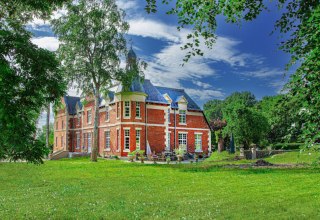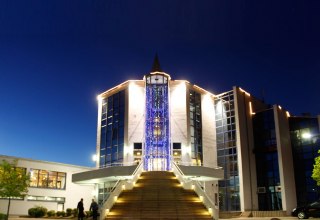The Botanical Garden is a scientific institution of the University of Rostock for research, teaching, education about the importance of biological diversity, and conservation of rare plant species. It is also available to the public as a source of information and a green oasis. Around 7,000 plant species are biologically cultivated in scientific departments, biotope facilities, greenhouses and a university garden on the 7.8 hectare landmark.
The open-air grounds
The Botanic Garden's open-air grounds contain the following main areas: The Systematic Section and the associated Arboretum group around 2500 plant species scientifically according to their phylogenetic relationship and bear witness to the progress in the evolution of the plant kingdom, which has proceeded along various developmental paths over many millions of years. The morphological-biological department focuses on the most diverse plant formations, which fulfil certain vital functions in adaptation to environmental conditions and can be characterised as plant functional types. Here, the role of plant organs in ensuring survival and reproduction is the trigger for the emergence of very diverse, but also astonishingly similar blueprints in different plant groups. In the Officinal Section, over 200 species used as medicinal, medicinal, spice, dyeing, fibre and technological plants are grouped according to their ingredients and corresponding uses. The section on the history of useful plants in north-eastern Germany presents around 60 plant species that have come to the area of what is now north-eastern Germany in different epochs since the Neolithic period and were used to a considerable extent.
In other areas of the garden, the biotopes, the plants are allowed to grow naturally. The requirements of the site and interactions with each other are the decisive factors here. In addition to the dune and the intermediate bog, the spring bog and wet meadow, the sandy dry grassland, the beech forest and the alder swamp as well as the stream and three ponds reflect the importance of the ecological habitat for the emergence of diversity in the plant kingdom. In the Alpinum it can be seen how the complex of extreme environmental factors on acidic and basic weathering parent rocks, which is effective in the high montane and subalpine levels, has produced peculiar and very flower-coloured adaptations, which also show interesting similarities in systematically very different groups. Around 1500 species are housed here. Smaller plants include the Japanese garden, a collection of evergreen species and a bed area with protected native plant species. A so-called university garden, an area for garden therapy and a bee information garden are run by external partners.
The greenhouses
The greenhouses contain collections (about 1000 species) of tropical useful and rainforest plants, subtropical species from various deserts and semi-deserts of the earth, and Mediterranean species from four continents. The geographical focus is on the Old World (Palaeotropics) with Africa, Madagascar and the Canary Islands. Special collections include a number of desiccation-tolerant vascular plants and carnivorous plants that are the focus of research projects.
All greenhouses in the Botanic Garden are primarily used for university teaching and research and are not structurally equipped for larger and sustained visitor traffic. We ask for your understanding that they can therefore only be opened to the public on Tuesdays to Thursdays during the working hours of the greenhouse gardeners and for the Sunday guided tours.



















